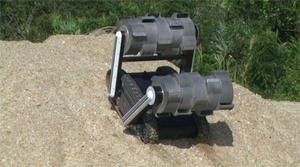RoboticsNASA engineers building sturdy blue-collar mining robot
After decades of designing and operating robots full of scientific gear to study other worlds, NASA is working on a prototype that leaves the delicate instruments at home in exchange for a sturdy pair of diggers and the reliability and strength to work all day, every day for years.

RASSOR-2n NASA's 'blue-collar' digger // Source: nasa.gov
After decades of designing and operating robots full of scientific gear to study other worlds, NASA is working on a prototype that leaves the delicate instruments at home in exchange for a sturdy pair of diggers and the reliability and strength to work all day, every day for years.
Think of it as a blue collar robot.
Dubbed RASSOR, for Regolith Advanced Surface Systems Operations Robot and pronounced “razor,” the autonomous machine is far from space-ready, but the earliest design has shown engineers the broad strokes of what their lunar soil excavator needs in order to operate reliably.
“We were surprised at what we could do with it,” said Rachel Cox, a Kennedy Space Center engineer on the RASSOR team.
A NASA release reports that the primary challenge for any digging robot operating off Earth is that they have to be light and small enough to fly on a rocket, but heavy enough to operate in gravity lower than that of Earth.
“The lighter you make your robot, the more difficult it is to do this excavating,” said A. J. Nick, an engineer on the RASSOR team.
RASSOR tackles this problem by using digging bucket drums at each end of the robot’s body that rotate in opposite directions, giving enough traction on one end to let the opposite side dig into the soil.
The team built a weight off-loading harness that simulated working the rover in the moon’s 1/6th gravity field.
“We proved that if you engage one bucket, it pulls itself but when you lower the other bucket and rotate it, once they both catch in, it starts digging,” Nick said.
Another secret of the drum, inspired by a previous Lockheed Martin design, is the staggered shallow scoops that shave the soil a bit at a time rather than scoop large chunks of it all at once, the way bulldozers do on Earth.
A concept mission for RASSOR would have a 2,000 pound payload in addition to the lander, which would be about the size of the Phoenix lander NASA sent to Mars. The RASSOR is expected to weigh about 100 pounds. The remaining payload would be used to process the lunar soil delivered by RASSOR.
The RASSOR looks like a small tank chassis with a drum at either end, each attached with arms. The drums are perhaps the robot’s most innovative feature. Because they are mounted on moving arms, they can act almost as legs letting the robot step
